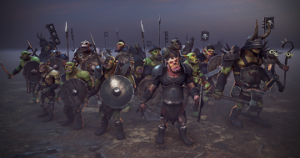This is RPG-ology #58: Random Encounters, for September 2022.
Someone somewhere asked a group of people for tips on running games, rather generically, and it struck me that there were probably several lessons I’ve learned over the decades that have made my games run more smoothly. Two months ago I happened to share one (using Voices to distinguish non-player characters). This is another, and although we are going to continue resurrecting the lost Game Ideas Unlimited series, we will intersperse some of these ideas going forward. This idea pertains to how to streamline the use of random encounters in play.

When I first started running games, the rules called for a random roll at fixed intervals to determine whether the characters would happen to stumble into a group of “monsters” in the game sense of the word–that is, they could be human, they could be friendly, but they were an unknown quantity that weren’t on the map. Dutifully I would roll the dice, then when it came up as a random encounter I would roll against the table to see what, and then frantically I would create the basics of the group, finding combat stats and rolling hit points. Most of the time these would become combat encounters, and the player characters would defeat them. At that point I had to roll up what treasure they had. The awkward thing is that at this point I would often learn that the now dead enemy had magic weapons, armor, and other objects that might have made a difference had they used them in combat–but I had not known these would come up on the treasure rolls. This plagued my games until I realized one essential fact:
Random encounters are no less random if they are randomly rolled in advance.
This revelation made a significant difference. Even so, it took a while for me to understand it fully. The first thing I did was start running through the tables of what might wander through, and roll up the details for each; that way when I rolled that monster I already had the details written down somewhere. This was a lot of work, and a lot of paper, and had the problem that if the party faced the same wandering monster twice in the same night I was caught flat-footed the second time. My improvement on this was to create monsters that were known to wander in particular areas of the dungeon, and allow the party to “clean them out” over time. But there was one more step that made it all work smoothly. I had to realize that the next random encounter was no less random if I rolled everything about it months in advance and used it when the dice called for it.
To clarify, when I create a level of a dungeon or a wilderness area or a ruin or some other encounter area for players to explore, I also check the list of what kinds of encounters they might randomly have in such an area, and roll several–five or six, perhaps. I then roll everything about them–hit points, weapons, pocket change, treasure, magic items. When I’m done, I have the group complete, and all that remains to be randomly determined is when the party encounters it.
So I’m not fumbling at the table trying to create and understand this next monster; it’s already done. When I’ve gone through a few, I create a few more; if one isn’t killed, I modify it in appropriate ways and put it back in the pile for later use. My random encounters are still random, and a complete surprise for my players–but they don’t surprise me.
And that’s the best advice I have for including random encounters and wandering monsters in your scenarios.
Previous article: Ives Loves a Parade.
Next article: David.
